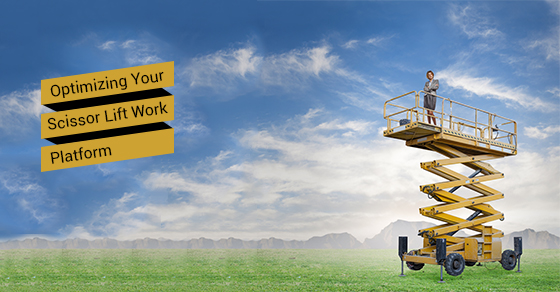Scissors lifts are an incredible asset to the manufacturing process in the sense that they bring the worker to the work, rather than bring the work to the worker. Industrial scissors lifts have been used for over 50 years in order to position material, tools, equipment, personnel, and other such items.
If you are using scissors lifts as a work platform, there are a variety of must-haves in terms of:
- Protecting the operator/riders
- Guarding the lift operating zone
- Improving work access and operator efficiency
The must-haves for protecting the operator/riders include:
- OSHA-Compliant Handrail System: This is a guardrail system installed around the perimeter of the elevated working surface. It guards the operating and non-operating sides of the lift platform.
- Maintained Contact Operator Pushbutton Station: This is a mandatory press and hold operator controls. This system allows the operator to have full control of the movement of the lift which decreases the chance of accidents.
- Non-Skid Walking Surface: All stair treads should be reasonably slip-resistant and the walking area of the platform must have a slip resistance surface.
- Lift Fall Arrest System: Lifts must have the capability to slow down the speed of a lift in the case of an outage of electricity or hydraulic pressure.
- Personnel Access Gates: These are gates that protect the openings when operators/riders enter and exit the lift.
- Emergency/Manual Lowering Valve: This is a means to lower the working platform if an emergency should occur.
- OSHA-Compliant Personal Fall Arrest System: A system attached to the worker including anchorage, connectors, body belt/harness, and a lanyard/life line.
The must-haves for guarding the lift operating zone include:
- Lift-In-Motion Audible/Visual Alarm: This alarm alerts personnel that the lift is moving or about to move.
- Safety Enclosure System: This prevents personnel from being beneath the lift when it is moving downwards.
- Flexible Protective Skirting: Vinyl skirting that surrounds the scissors mechanism.
- Shear Point Protection: The edge of the platform which creates a shear point between the moving and fixed landing must be protected.
- Handrail Filler Material: Handrails can be filled with material to create a more effective barrier between the floor and overhead workers.
- Interference Detection: This involves installing sensors that will stop lift movement when they come into contact with employees or equipment.
The must-haves for improving work access and operator efficiency include:
- Lift Mobility: Manual or powered means of mobility for the lift.
- Shuttling/Sliding Platform Extensions: Adjust the location of the work platform walking surface.
- On-Board Utilities: Utility boxes placed on the work platform to provide electrical power if need be.
- On-Board Lifting Devices: Material handling equipment that is mounted on the work platform surface to handle objects weighing over 40 lbs.
- Adjustable and Belly Bar Handrail Systems
If you are using scissors lifts to increase worker productivity and safety as well as improving your manufacturing flexibility, do take these must-haves into consideration.


